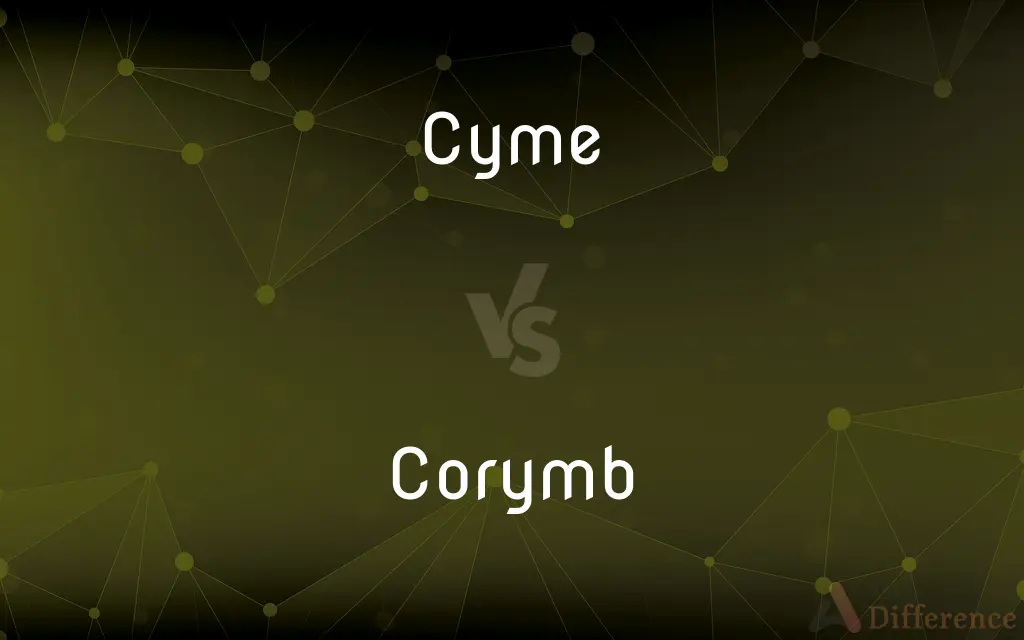Cyme vs. Corymb — What's the Difference?
By Maham Liaqat & Urooj Arif — Updated on March 10, 2024
A cyme is a flat-topped or rounded flower cluster where flowers bloom from the center outward, whereas a corymb is a flower cluster with stalks of varying lengths, making the top appear flat or slightly rounded.

Difference Between Cyme and Corymb
Table of Contents
ADVERTISEMENT
Key Differences
A cyme, specifically a determinate inflorescence, features a central flower that blooms first, halting the elongation of the central axis and allowing subsequent flowers to form from lateral buds, creating a more or less flat or rounded cluster. In contrast, a corymb presents an indeterminate inflorescence pattern where lower flowers on longer stalks bloom later than those above, leading to a level or rounded top appearance despite the varying lengths of flower stalks.
While cymes often exhibit a more compact and rounded form, with each successive flower blooming outward from the central point, corymbs can appear more spread out due to the differing stalk lengths, which adjust to bring all flowers to a similar height, creating the illusion of a flat-topped cluster despite the varying blooming order.
Cymes can display a variety of forms, such as simple, compound, or helicoid, adapting to different plant species and environmental conditions, whereas corymbs maintain a more consistent structure across species, with the primary variation being the length of the individual flower stalks to achieve the characteristic flat-topped appearance.
In terms of biological function, both cymes and corymbs maximize the plant's reproductive efficiency by spacing out flowers for better access to pollinators. However, the determinate growth of cymes means that the plant focuses energy on producing a set number of flowers, while the indeterminate nature of corymbs allows for continued flower production as long as conditions are favorable.
The distinction between cymes and corymbs is not just botanical but also ecological, as each type of inflorescence attracts specific pollinators and fits into its ecosystem uniquely. The architectural difference influences how pollinators interact with the flowers, with cymes offering a more predictable pattern and corymbs presenting a visually consistent but temporally staggered blooming sequence.
ADVERTISEMENT
Comparison Chart
Inflorescence Type
Determinate
Indeterminate
Blooming Pattern
Central flowers bloom first, outward progression.
Upper flowers bloom first, with longer lower stalks.
Shape
Rounded or flat-topped, compact.
Flat-topped or slightly rounded, can be spread out.
Growth
Terminal flower stops central axis elongation.
Continuous growth with varied stalk lengths.
Ecological Role
Specific pollinator attraction, efficient reproduction.
Adapts to pollinators with visually consistent height.
Compare with Definitions
Cyme
A rounded flower cluster.
The lilac's blooms form a beautiful cyme.
Corymb
A flat-topped flower cluster.
The yarrow exhibits a characteristic corymb inflorescence.
Cyme
Determinate inflorescence.
The central flower in a cyme blooms first, setting the pattern.
Corymb
Varied stalk lengths.
Corymbs achieve their shape through stalks of different lengths.
Cyme
Compact flower arrangement.
Cymes in verbena create dense floral displays.
Corymb
Indeterminate inflorescence.
Flowers in a corymb keep forming as long as conditions are favorable.
Cyme
Outward blooming sequence.
Each successive ring of flowers in a cyme expands from the center.
Corymb
Level appearance.
Despite individual growth rates, a corymb's top appears uniformly flat.
Cyme
Ecological adaptation.
Cymes in some species are tailored to specific pollinator behaviors.
Corymb
Pollinator attraction.
The corymb's structure is designed to maximize visibility to pollinators.
Cyme
A usually flat-topped or convex flower cluster in which the main axis and each branch end in a flower that opens before the flowers below or to the side of it.
Corymb
Corymb is a botanical term for an inflorescence with the flowers growing in such a fashion that the outermost are borne on longer pedicels than the inner, bringing all flowers up to a common level. A corymb has a flattish top with a superficial resemblance towards an umbel, and may have a branching structure similar to a panicle.
Cyme
A “head” (of unexpanded leaves, etc.); an opening bud.
Corymb
A usually flat-topped flower cluster in which the individual flower stalks grow upward from various points of the main stem to approximately the same height.
Cyme
(botany) A flattish or convex flower cluster, of the centrifugal or determinate type, on which each axis terminates with a flower which blooms before the flowers below it. Contrast raceme.
Corymb
(botany) A cluster of flowers with a flat or convex top.
Cyme
(architecture) = cyma
Corymb
A flat-topped or convex cluster of flowers, each on its own footstalk, and arising from different points of a common axis, the outermost blossoms expanding first, as in the hawthorn.
Cyme
Misspelling of senna
Corymb
Flat-topped or convex inflorescence in which the individual flower stalks grow upward from various points on the main stem to approximately the same height; outer flowers open first
Cyme
A flattish or convex flower cluster, of the centrifugal or determinate type, differing from a corymb chiefly in the order of the opening of the blossoms.
Cyme
More or less flat-topped cluster of flowers in which the central or terminal flower opens first
Common Curiosities
What ecological role do cymes and corymbs play?
Both inflorescence types optimize flower exposure to pollinators, but their structure may attract different pollinators or fit different ecological niches.
What defines a cyme in botany?
A cyme is a flower cluster with a central bloom that opens first, leading to a determinate growth pattern.
How do gardeners use knowledge of cymes and corymbs?
Understanding these inflorescence types helps gardeners predict blooming patterns and choose plants that complement each other in gardens.
Does the climate influence the formation of cymes or corymbs?
Climate can affect the development and appearance of both cymes and corymbs, with certain types being more prevalent in specific climates.
Can the type of inflorescence change over a plant's lifetime?
While inflorescence type is generally consistent within a species, environmental stress or genetic factors can sometimes lead to variations.
How do cymes and corymbs affect a plant's reproduction?
Their structures influence pollination efficiency, with each type offering different advantages for attracting and accommodating pollinators.
Are there any cultural or symbolic meanings associated with cymes and corymbs?
In some cultures, specific plants with cymes or corymbs may carry symbolic meanings, often related to their appearance or medicinal properties.
How does a corymb differ from other inflorescences?
A corymb is characterized by its flat-topped appearance, achieved through stalks of varying lengths, making it distinct from more rounded or pyramid-shaped clusters.
Can cymes and corymbs be found in the same plant species?
While uncommon, some plant species may exhibit both inflorescence types under different conditions or in different parts of the plant.
Do cymes or corymbs require specific soil conditions?
Soil conditions affect overall plant health but do not directly determine inflorescence type; however, optimal conditions can enhance the display of either type.
Are cymes or corymbs more common in wildflowers?
Both types are common in wildflowers, with their prevalence depending on the specific habitat and ecological requirements of the plants.
What maintenance does a garden with predominantly corymb-bearing plants require?
Such gardens may need regular pruning to maintain the desired shape and maximize flower visibility for pollinators.
How do pests and diseases affect cymes and corymbs?
Infestations can impact the growth and appearance of these inflorescences, potentially disrupting their blooming patterns and ecological roles.
How does urbanization impact plants with cymes or corymbs?
Urban environments can influence the prevalence and health of such plants, affecting their growth patterns and interactions with pollinators.
Share Your Discovery

Previous Comparison
Regiochemistry vs. Stereochemistry
Next Comparison
Explorer vs. TouristAuthor Spotlight
Written by
Maham LiaqatCo-written by
Urooj ArifUrooj is a skilled content writer at Ask Difference, known for her exceptional ability to simplify complex topics into engaging and informative content. With a passion for research and a flair for clear, concise writing, she consistently delivers articles that resonate with our diverse audience.














































